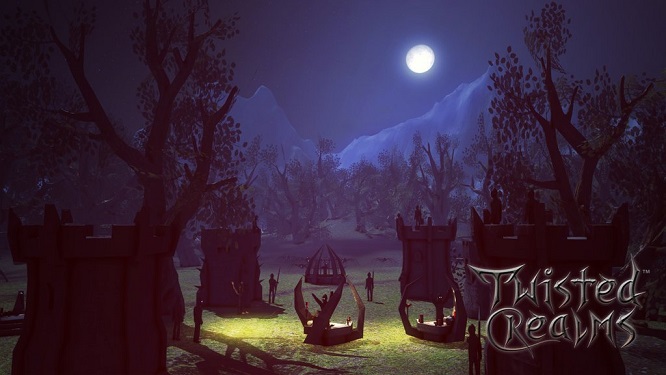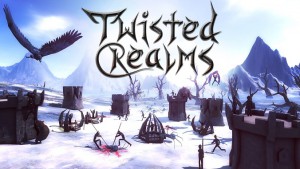Earlier this week you may have seen VRFocus report that Twisted Realms developer Aldin Dynamics is working on a brand new virtual reality (VR) videogame that supports position tracked input. A full reveal of that experience is expected ‘very soon’ but, for now, here’s the full interview with the developer surrounding its recently released project for the Gear VR mobile-based head-mounted display (HMD).
In the Q&A below Hrafn Thorri Thorisson, CEO of Aldin Dynamics and Managing Director Gunnar Steinn Valgardsson talk about their tower defense title that can be picked up now. They touch upon the decision to work on Gear VR having already worked on the Oculus Rift’s development kits with its short experience, Asunder: Earthbound. They also talk about the possibility of seeing the project on other platforms and more.
VRFocus: Why did Aldin Dynamics side with Gear VR for its news VR project?
Aldin Dynamics (AD): We first tried a Gear VR development kit shortly after the Oculus Rift DK2 was unveiled and that was a very special and memorable moment. Even though it was raw and unpolished at the time, it was clear to us that Gear VR would become one of the leading platforms. We had previously written off mobile VR being something that would potentially work in the far future, but Samsung and Oculus managed to overcome many of the technical limitations that plague competing mobile headsets to this day.
VRFocus: Twisted Realms is very different to Asunder. Why did you decide to go with Tower Defence for VR?
AD: For us, this was never about a particular genre — we’re thinking in much broader terms. Twisted Realms was about exploring the entire concept of making a “casual game” for virtual reality, where the constraints and traditional user interfaces were an integral part of the experience.
During development the game design went through radical changes but the core was always a casual strategy type game played from a third person perspective. We experimented with a lot of different things and most of them never made it into the final product. We created a wide range of gameplay prototypes, with different locomotion methods, input schemes, interfaces and gameplay styles. Much like UsTwo in developing Land’s End for Gear VR, we wound up scrapping the Twisted Realms project entirely three times over — starting completely from scratch. Every iteration brought new insights into how to properly balance user comfort, interface design, graphical optimizations and gameplay.
We’re highly strategic in choosing what to work on at any given time. With Asunder we were focused on answering fundamental questions about user behavior in VR within a cinematic setting, pioneering a new category of experiences and gameplay mechanics in the process. With Twisted Realms we were looking carefully at the process of properly transforming known concepts to VR and how to bridge the gaps that emerge. It’s part of a long-term plan that puts us on a path towards creating the best possible experiences.
It’s going to take time before developers fully unleash the medium’s potential. We are building towards those advanced VR experiences, but in order to get where we want, we need to build up resources, knowledge and a set of tools. That’s what we’re doing with each of our products, from Trial of the Rift Drifter to Twisted Realms; we’re on a journey of discovery.
VRFocus: How do you think VR enhances the genre?
AD: We see VR as something new and incomparable to monitor-based precedents, regardless of any superficial resemblance. VR development today is about identifying the cornerstones of design — developing the bricks and raw construction materials that we can use to build new genres, or adapt conventional ones. We designed a lot of different bricks during the development of Twisted Realms, some of them enhanced the user experience, and others didn’t work as well. Many of the things we tried didn’t make it into the final consumer product, and we’re excited to continue exploring those options as mobile VR becomes more powerful.
At one point, for example, we even toyed with tracked input using the phone’s camera and printable QR codes, aiming to let players physically arrange and manipulate towers with their hands in real-time. Working against CPU, battery life and user comfort constraints, however, a lot of what we tried never made it into the final product. Some features just wound up not suiting this particular game, others clashed with some of mobile VR’s constraints. There’s a lot of this going on in the VR space right now. Developers are working on really cool experimental features behind the scenes that won’t make it into consumer products until a year or two from now, simply because they’re still too experimental for one reason or another.
The key thing for us was to make a fun and comfortable experience that would allow a beginner VR user to jump right in and start playing, balancing unique VR features against conventional mechanics that would feel comfortable, familiar and intuitive.
VRFocus: Could Twisted Realms come to other HMDs such as the Oculus Rift?
AD: All of our in-house experiments show a huge potential for large-scale, real-time strategy games in VR. We have in-house versions of Twisted Realms that utilize positional tracking for the DK2 and it really enriches the entire gameplay experience. We’ve also experimented with epic battle scenes that involve hundreds of enemy units. We see enormous potential in expanding Twisted Realms to high-end VR platforms in the future, but presently we are only focused on Gear VR.
VRFocus: Would you consider making a sequel to the title?
AD: Much of our vision for Aldin has to do with VR experiences that require more computing power, and that’s where the core of our focus will be going forward. But mobile VR can also teach valuable VR design lessons, especially about working against very strict constraints. It offers unique opportunities and advantages that will continue to grow very rapidly. Our studio works exclusively on VR and we aim to have working experience with all platforms that can offer quality experiences.
For now our attention is back on the PC side of VR, building on what we learned in creating Trial of the Rift Drifter, Asunder and Twisted Realms. We’ve been around for longer than many in the VR space, but even so we are just getting started.
VRFocus: Are you working on any other VR videogames right now?
We certainly are! Right now we’re working on a new experience for tracked input that we’ll unveil very soon
-END-
The post Aldin Dynamics Talks Twisted Realms, VR Experiments and New Projects appeared first on VRFocus.
















